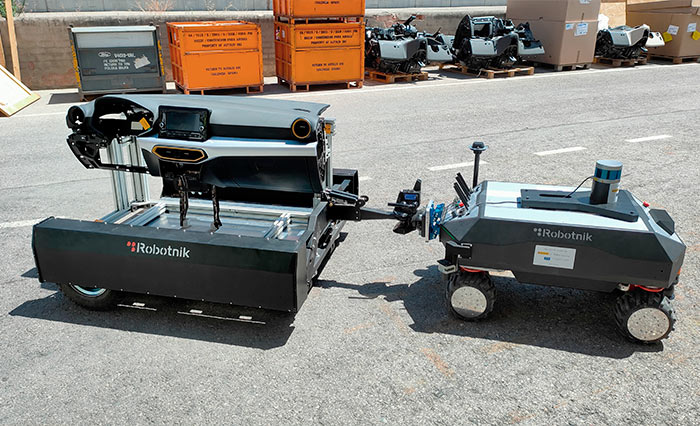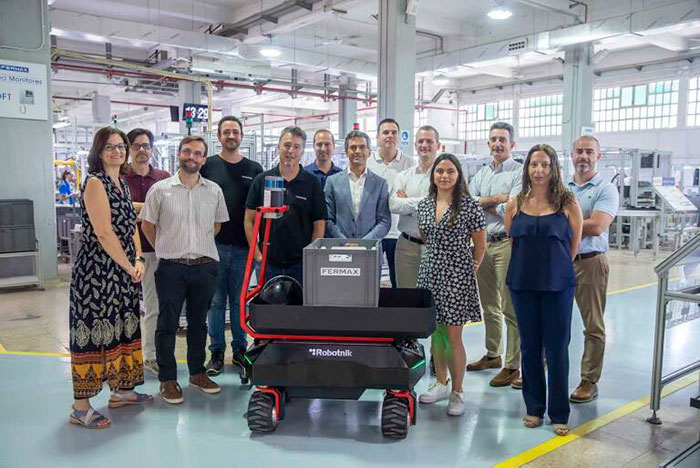Read about a use case illustrating the growing potential in industry of 5G Robots.
- Fermax and FORVIA/Faurecia host two demos at their facilities to test how 5G technology improves the management of fleets of robots for transporting goods within the industry.
- Robotnik, a Valencian company and pioneer in the use of mobile autonomous 5G robots is responsible for these two pilot tests.
- Both demonstrations are part of the National 5G Plan, the programme for the development of 5G technology pilot projects implemented by Red.es.
FERMAX and FORVIA /Faurecia are the two industrial manufacturing plants where the possibilities offered by a 5G robot for indoor and outdoor goods transport have been demonstrated.
Robotnik, in collaboration with Orange and Fivecomm, has been responsible for the execution of these pilot tests, which are part of the final result of the
PILOTOS 5G project, part of the National 5G Plan, a programme for the development of 5G technology pilot projects carried out by the public business entity Red.es, promoted by the Spanish Ministry of Economy and Digital Transformation and co-financed by the European Regional Development Fund (FEDER).
In both demonstrations, Robotnik’s RB-VOGUI mobile robot performed autonomous and collaborative logistics tasks in transport and material provisioning. It was shown how 5G connectivity optimises the management and performance of a robot fleet in industrial environments thanks to the benefits it brings. These include speed of response, as it increases the speed of information transmission; increased precision and speed in operations; improved connectivity: the reduction in network latency of 5G solves the limitations of wired logic technologies (Bluetooth, WiFi…); and cost reduction due to the reduction of possible operational errors and increased productivity.
5G robots for logistics
At the FORVIA/Faurecia site, the RB-VOGUI mobile robot has demonstrated its capability to perform both indoor and outdoor trolley-driven transport of materials. The aim is to automate last-mile logistics, thereby reducing processes and costs.
At Fermax, the mobile robot with 5G, autonomously transports missing parts from one point of the production line to another, thus avoiding downtime in the manufacturing process.
In both cases, while the robots carry out the various tasks, the operators receive streaming from the cameras and information from the 3D point cloud, and can also take control remotely at any time.
Robotnik’s managers of use case 6, to which both pilots belong, state that ‘the main objective of this use case has been achieved: the development of remotely controlled transport robots that allow, both outdoors and indoors, to automate logistic tasks in a manufacturing environment where further integration, robotisation and optimisation of the load distribution chain is required’.
Project partners
This use case is being developed as part of Red.es’ PILOTOS 5G Valencia project, within the National 5G Plan and the National Plan for Intelligent Territories. Both are promoted by the Spanish Ministry of Economy and Digital Transformation and co-financed with FEDER funds. This Plan aims to stimulate the definition and implementation of multiple use cases of this technology through the constitution of an ecosystem of technological partners, who will join forces to accelerate the process in order to make the so-called “digital economy” a reality in the near future.
PILOTOS 5G is driven by a Joint Venture (JV) involving, besides Robotnik, companies such as Orange, Visyon (MEDIAPRO Group), Robotnik, CFZ Cobots, Elewit (Red Eléctrica Group), Aracnocoptero, Idrica, ETRA and other collaborating entities.




